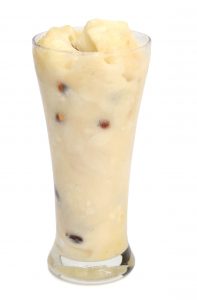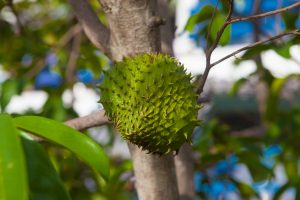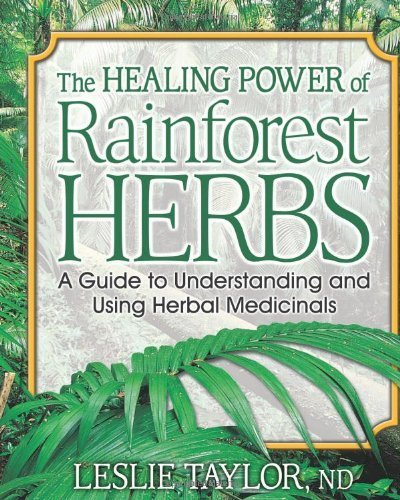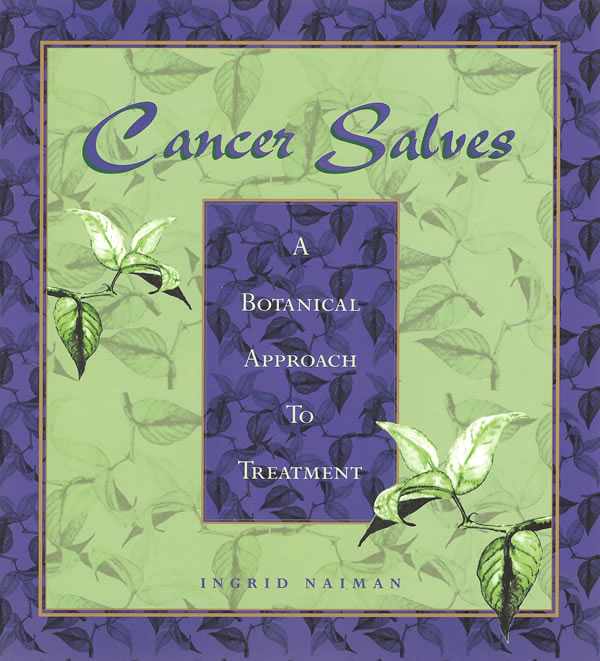Graviola
Guest Author: Dr. Leslie Taylor

Botanical Name: Annona muricata
Synonyms: Annona macrocarpa, A. bonplandiana, A. cearensis, Guanabanus muricatus
Common Names: Graviola, soursop, guanábana, guanábano, guanavana, guanaba, corossol épineux, huanaba, toge-banreisi, durian benggala, nangka blanda, cachiman épineux
Parts of the Plant that are Used
Leaves, fruit, seeds, bark, roots.
Plant Description
|
Graviola is a small, upright evergreen tree, 5-6 m high, with large, glossy, dark green leaves. It produces a large, heart-shaped, edible fruit that is 15-23 cm in diameter, is yellow-green in color, and has white flesh inside. Graviola is indigenous to most of the warmest tropical areas in South and North America, including the Amazon. The fruit is sold in local markets in the tropics, where it is called guanábana in Spanish-speaking countries and |
 |
|
|
Soursop Juice |
Documented Properties and Actions
Antibacterial, anthelmintic, anticancerous, anticonvulsant, antidepressant, antifungal, antimicrobial, antineoplastic, antiparasitic, antispasmodic, antitumorous, antiviral, astringent, cardiodepressant, cytostatic, cytotoxic, febrifuge, hypotensive, insecticide, nervine, pectoral, piscicide, sedative, stomachic, vasodilator, and vermifuge.
Plant Chemicals
Annonaceous acetogenins: annocatalin, annohexocin, annomonicin, annomontacin, annomuricatin A & B, annomuricin A thru E, annomutacin, annonacin, (multiple iso, cis, one, etc.), annonacinone, annopentocin A thru C, cis-annonacin, cis-corossolone, cohibin A thru D, corepoxylone, coronin, corossolin, corossolone, donhexocin, epomuricenin A &B, gigantetrocin, gigantetrocin A & B, gigantetrocinone, gigantetronenin, goniothalamicin, iso-annonacin, javoricin, montanacin, montecristin, muracin A thru G, muricapentocin, muricatalicin, muricatalin, muri-catenol, muricatetrocin A & B muricatin D, muricatocin A thru C, muricin H, muricin I, muricoreacin, murihexocin 3, murihexocin A thru C, murihexol, murisolin, robustocin, rolliniastatin 1 & 2, saba-delin, solamin, uvariamicin I & IV, xylomaticin.
Plant Uses
All parts of the

Graviola has a long, rich history of use in herbal medicine as well as lengthy recorded indigenous use. In the Peruvian Andes, a leaf tea is used for catarrh (inflammation of mucous membranes) and the crushed seed is used to kill parasites. In the Peruvian Amazon the bark, roots, and leaves are used for diabetes and as a sedative and antispasmodic. Indigenous tribes in Guyana use a leaf and/or bark tea as a sedative and heart tonic. In the Brazilian
Many bioactive compounds and phytochemicals have been found in
In a 1976 plant screening program by the National Cancer Institute,
“Annonaceous acetogenins can selectively inhibit the growth of cancerous cells and also inhibit the growth of adriamycin resistant tumor cells.
Annonaceous acetogenins are only found in the Annonaceae family (to which
In 1997, Purdue University published information with promising news that several of the Annonaceous acetogenins ” . . . not only are effective in killing tumors that have proven resistant to anticancer agents, but also seem to have a special affinity for such resistant cells.” In several interviews after this information was publicized, the head pharmacologist in Purdue’s research explained how this worked. As he explains it, cancer cells that survive chemotherapy can develop resistance to the agent originally used as well as to other, even unrelated, drugs. This phenomenon is called multi-drug resistance (MDR). One of the ways that cancer cells develop resistance to chemotherapy drugs is by creating an intercellular efflux pump called a P-glycoprotein mediated pump. These types of pumps are capable of pushing anticancer agents out of the cell before they can kill it. On average, only about two percent of the cancer cells in any given person might develop this pump–but they are the two percent that can eventually grow and expand to create multi-drug-resistant tumors. Some of the latest research on acetogenins reported that they were capable of shutting down these intercellular pumps, thereby killing MDR tumors. Purdue researchers reported that the acetogenins preferentially killed multi-drug-resistant cancer cells by blocking the transfer of ATP–the chief source of cellular energy–into them. A tumor cell needs
An interesting in vivo study was published in March of 2002 by researchers in Japan, who were studying various acetogenins found in several species of plants. They inoculated mice with Lewis lung carcinoma cancer cells. One third received nothing, one third received the chemotherapy drug adriamycin, and one third received the main
Cancer research is ongoing on these important plants and plant chemicals, as several pharmaceutical companies and universities continue to research, test, patent, and attempt to synthesize these chemicals into new chemotherapeutic drugs. In addition, researchers have reported that NADH dehydrogenase inhibitors can suppress HIV infection. As this is a familiar property of Annonaceous acetogenins, several acetogenins found in
One researcher summarized his work eloquently: “At the time of preparation (August 1998) of this current review, over 350 Annonaceous acetogenins have been isolated from 37 species. Our preliminary efforts show that about 50%, of over 80 Annonaceous species screened, are significantly bioactive and are worthy of fractionation; thus, this class of compounds can be expected to continue to grow at an exponential rate in the future, provided that financial support for such research efforts can be found. With the demise of the world’s tropical rain forests, such work is compelling before the great chemical diversity, contained within these endangered species, is lost.” Perhaps–if enough people believe that the possible cure for cancer or AIDS truly is locked away in a rainforest plant–we will take the steps needed to protect our remaining rainforests from destruction.
Traditional Remedy
The therapeutic dosage is reported to be 5-7 grams daily in capsules or tablets (in 3-4 divided dosages). A standard infusion (one cup 2-3 times daily) or a 4:1 standard tincture (2-4 ml three times daily) can be substituted if desired.
Contraindications
Graviola has demonstrated uterine stimulant activity in an animal study (rats) and should therefore not be used during pregnancy.
Graviola has demonstrated hypotensive, vasodilator, and
Graviola has demonstrated significant in vitro antimicrobial properties. Chronic, long-term use of this plant may lead to
Graviola has demonstrated emetic properties in one animal study with pigs. Large single dosages may cause nausea or vomiting. Reduce the usage accordingly if this occurs.
One study with rats given a stem-bark extract intragastrically (at 100 mg/kg) reported an increase in dopamine, norepinephrine, and
Alcohol extracts of
Drug Interactions: None have been reported; however,

Rainforests contain an amazing abundance of plant life―over half of the planet’s vegetation. For centuries, tribal shamans have successfully used these botanicals as remedies for various health disorders. Now, scientists have begun to uncover the medicinal qualities of these plants, which offer new approaches to health and healing.
The Healing Power of Rainforest Herbs is a unique guide to these herbs and their uses.
$23.75
Ethnobotany: Worldwide Uses
Caribbean
Antispasmodic, chill, fever, flu, indigestion, nervousness, palpitation, rash, sedative, skin disease
Haiti
Asthenia, cataplasm, cicatrizant, cough, diarrhea, emetic, fever, grippe, heart conditions, lactagogue, nervine, parasites, pediculicide, pellagra, sedative, soporific, sore, spasm, stomachic
Jamaica
Antispasmodic, asthenia, asthma, diuretic, fevers, heart conditions, hypertension, lactagogue, nervine, parasites, sedative, vermifuge
Trinidad
Depurative, fainting, flu, galactagogue, high blood pressure, hypertension, insomnia, palpitation, ringworms
West Indies
Asthma, childbirth, diarrhea, hypertension, lactagogue, parasites, worms
Curaçao
Childbirth, gallbladder, nervousness, parturition, sedative, tea, tranquilizer
Mexico
Astringent, diarrhea, dysentery, fever, liqueur, pectoral, ringworm, scurvy
Panama
Anthelmintic, diarrhea, dyspepsia, kidney, piscicide, ulcer (stomach), vermifuge
Brazil
Abscess, analgesic, anthelmintic, antispasmodic, astringent, bronchitis, calmative, chest problems, cough, diabetes, diarrhea, dysentery, edema, emetic, fever, intestinal colic, liver problems, neuralgia, parasites, rheumatism
Peru
Antiparasitic, antispasmodic, catarrh, diabetes, diarrhea, dysentery, fever, hypertension, indigestion, insecticide, lice, liver disorders, sedative, tumors (skin), ulcers (internal)
Malaysia
Astringent, boil, cough, diarrhea, dermatosis, hypertension, rheumatism, styptic
Elsewhere
Analgesic, antiphlogistic, arthritis, asthma, astringent, bilious, childbirth, cyanogenetic, diarrhea, dysentery, febrifuge, heart, insecticide, kidney, lactagogue, liver, malaria, pectoral, pediculicide, piscicide, ringworm, scurvy, sedative, stomach, tranquilizer
Copyrighted by Sage Press, Inc. 2002
The above text has been reprinted with permission of the author. It appears on her web site and in her book, Herbal Secrets of the Rainforest, 2nd edition, published and copyrighted by Sage Press, Inc.© 2002 All rights reserved. No part of this document may be reproduced or transmitted in any form or by any means, electronic or mechanical, including photocopying, recording, or by any information storage or retrieval system, including websites, without written permission from Sage Press, Inc. A complete Technical Data Report is available for this plant from Sage Press, Inc.
References
Feng, P. C., et al. “Pharmacological screening of some West Indian medicinal plants.” J. Pharm. Pharmacol. 1962; 14: 556-61.
Meyer, T. M. “The alkaloids of Annona muricata.” Ing. Ned. Indie. 1941; 8(6): 64.
Carbajal, D., et al. “Pharmacological screening of plant decoctions commonly used in Cuban folk medicine.” J. Ethnopharmacol. 1991; 33(1/2): 21-4.
Misas, C. A. J., et al. “Contribution to the biological evaluation of Cuban plants. IV.” Rev. Cubana Med. Trop. 1979; 31(1): 29-35.
Sundarrao, K., et al. “Preliminary screening of antibacterial and antitumor activities of Papua New Guinean native medicinal plants.” Int. J. Pharmacog. 1993; 31(1): 3-6.
Heinrich, M., et al. “Parasitological and microbiological evaluation of Mixe Indian medicinal plants (Mexico).” J. Ethnopharmacol. 1992; 36(1): 81-5.
Lopez, Abraham A. M. “Plant extracts with cytostatic properties growing in Cuba. I.” Rev. Cubana Med. Trop. 1979; 31(2): 97-104.
Bories, C., et al. “Antiparasitic activity of Annona muricata and Annona cherimolia seeds.” Planta Med. 1991; 57(5): 434-36.
Antoun, M. D., et al. “Screening of the flora of Puerto Rico for potential antimalarial bioactives.” Int. J. Pharmacog. 1993; 31(4): 255-58.
Gbeassor, M., et al. “In vitro antimalarial activity of six medicinal plants.” Phytother. Res. 1990; 4(3): 115-17.
Tattersfield, F., et al. “The insecticidal properties of certain species of Annona and an Indian strain of Mundulea sericea (Supli).” Ann. Appl. Biol. 1940; 27: 262-73.
Hasrat, J. A., et al. “Isoquinoline derivatives isolated from the fruit of Annona muricata as 5-HTergic 5-HT1A receptor agonists in rats: unexploited antidepressive (lead) products.” J. Pharm. Pharmacol. 1997; 49(11): 1145-49.
Anon. Unpublished data, National Cancer Institute. Nat Cancer Inst Central Files (1976). From NAPRALERT Files, University of Illinois, 1995.
Zeng, L., et al. “Five new monotetrahydrofuran ring acetogenins from the leaves of Annona muricata.” J. Nat. Prod. 1996; 59(11): 1035-42.
Rieser, M. J., et al. “Five novel mono-tetrahydrofuran ring acetogenins from the seeds of Annona muricata.” J. Nat. Prod. 1996; 59(2): 100-8.
Wu, F. E., et al. “Additional bioactive acetogenins, annomutacin and (2,4-trans and cis)-10R-annonacin-A-ones, from the leaves of Annona muricata.” J. Nat. Prod. 1995; 58(9): 1430-37.
Wu, F. E., et al. “New bioactive monotetrahydrofuran Annonaceous acetogenins, annomuricin C and muricatocin C, from the leaves of Annona muricata.” J. Nat. Prod. 1995; 58(6): 909-15.
Wu, F. E., et al. “Muricatocins A and B, two new bioactive monotetrahydrofuran Annonaceous acetogenins from the leaves of Annona muricata.” J. Nat. Prod. 1995; 58(6): 902-8.
Wu, F. E., et al. “Two new cytotoxic monotetrahydrofuran Annonaceous acetogenins, annomuricins A and B, from the leaves of Annona muricata.” J. Nat. Prod. 1995; 58(6): 830-36.
Rieser, M. J., et al. “Bioactive single-ring acetogenins from seed extracts of Annona muricata.” Planta Med. 1993; 59(1): 91-2.
Rieser, M. J., et al. “Muricatacin: a simple biologically active acetogenin derivative from the seeds of Annona muricata (Annonaceae)” Tetrahedron Lett. 1991; 32(9):1137-40.
Kim, G. S., et al. “Muricoreacin and murihexocin C, mono-tetrahydrofuran acetogenins, from the leaves of Annona muricata. Phytochemistry 1998; 49(2): 565-71.
Padma, P., et al. “Effect of the extract of Annona muricata and Petunia nyctaginiflora on Herpes simplex virus. J. Ethnopharmacol. 1998; 61(1): 81-3.
Gleye, C., et al. “Cis-monotetrahydrofuran acetogenins from the roots of Annona muricata 1. J. Nat. Prod. 1998; 61(5): 576-9.
Kim, G. S., et al. “Two new mono-tetrahydrofuran ring acetogenins, annomuricin E and muricapentocin, from the leaves of Annona muricata.” J. Nat. Prod. 1998; 61(4): 432-36.
Woo M.H., et al. “Cis-Annonacin and (2,4)-cis-and trans-isoannonacins: cytotoxic monotetrahydrofuran annonaceous acetogenins from the seeds of Annona cherimolia.” Arch. Pharm. Res. 1999 Oct;22(5):524-8.
Liaw, C. C., et al. “New cytotoxic monotetrahydrofuran Annonaceous acetogenins from Annona muricata.” J. Nat. Prod. 2002; 65(4): 470-75.
Chang, F. R., et al. “Novel cytotoxic annonaceous acetogenins from Annona muricata.” J. Nat. Prod. 2001; 64(7): 925-31.
Jaramillo, M. C., et al. “Cytotoxicity and antileishmanial activity of Annona muricata pericarp.” Fitoterapia 2000; 71(2): 183-6.
Betancur-Galvis, L., et al. “Antitumor and antiviral activity of Colombian medicinal lant extracts.” Mem. Inst. Oswaldo Cruz 1999; 94(4): 531-35.
Oberlies, N. H., et al. “Structure-activity relationships of diverse Annonaceous acetogenins against multidrug resistant human mammary adenocarcinoma (MCF-7/Adr) cells.” J. Med. Chem.; 40(13):2102-6 1997.
Keinan, E., et al. “Antibody-catalyzed organic and organometallic transformations and chemical libraries of Annonaceous acetogenins.” The Skaggs Institute for Chemical Biology Scientific Report 1997-1998.
Zeng, L., et al., “Recent advances in Annonaceous acetogenins.” Nat. Prod Rep. 1996; 13(4): 275-306.
Anon., Purdue News September 1997; Purdue University, West Lafayette, IN. http://www.purdue.edu
Feras, Q., et al. “Annonaceous acetogenins: Recent progress.” J. Nat. Prod. 1999; 62(3): 504-540.
Wang, L. Q., et al. “Annonaceous acetogenins from the leaves of Annona montana.” Bioorg. Med. Chem. 2002; 10(3): 561-65.
Padma, P., et al. “Effect of Annona muricata and Polyalthia cerasoides on brain neurotransmitters and enzyme monoamine oxidase following cold immobilization stress.” J. Natural Remedies 2001; 1(2): 144-46.
N’gouemo, P., et al. “Effects of ethanol extract of Annona muricata on pentylenetetrazol-induced convulsive seizures in mice.” Phytother. Res. 1997; 11(3): 243-45.
Image Credits
Graviola Fruit
Dreamstime ID 101742412
© Inna Kyselova
Annona muricata Fruit
Soursop Juice
Dreamstime ID 90621781
© Phong Giap
Soursop Fruit on Tree
Dreamstime ID 55829897
© Viktoriia Zlobina
Cook Islander Explaining Graviola
Dreamstime ID 112012852
© Rafael Ben Ari
Eco Tour in Rarotonga
Many experts throughout history have regarded cancer salves and pastes as the most thorough, safe, and efficacious way to treat cancer, especially skin and breast cancers but also cancers of other organs. In this book, Ingrid Naiman meticulously traces the use of such products in ancient India and by Hildegard of Bingen, Native Americans, and modern physicians. She provides detailed instructions for making and using the salves, a fair comparison of the pros and cons, and eight pages of color pictures showing responses to the products. Visit her Cancer Salves site for more information, answers to frequently asked questions, and a checklist for people facing cancer.

Cancer Plants
Donations
Your donations are greatly appreciated.
Information
Newsletter
To be notified of new posts to this site, please subscribe, using the link button below. You can cancel your subscription at any time you choose.
Copyright by Dr. Ingrid Naiman 2003 and 2018
All Rights Reserved || Institute for Invisible Epidemics
